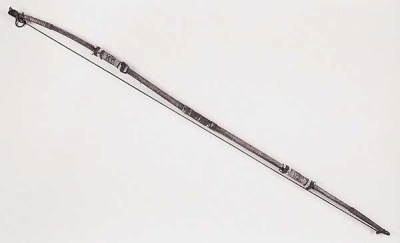Hunting bow (1893.67.24)
 USAHunting bow from the USA, Americas. Collected by Edward Martin Hopkins in 1842. Purchased by the Museum from him in 1893.
USAHunting bow from the USA, Americas. Collected by Edward Martin Hopkins in 1842. Purchased by the Museum from him in 1893.
This is a takintazipa, a hunting bow used by the Lakota Sioux people of North and South Dakota. It measures 1.2 metres long and is made of wood and sinew (takan = 'sinew', itazipa = 'bow'). It is covered with snake-skin, the ends are bound with hide and the there are bands of coloured quill- and beadwork on both arms.
A Place in History
Such bows, although not possessing the same performance qualities of many other bows from the Old and New Worlds, represent a triumph of ingenuity over highly limited materials. One of the major obstacles to the Lakota Sioux bowyer was the lack of trees on the Great Plains of North and South Dakota. Those woods he could find were often less flexible than those available to his neighbours on the southern Plains. To compensate for this, the Lakota increased the bow's flexibility by adding a layer of sinew along the back. It was also possible to overcome the limitations of the materials used by adapting the bow's shape.
This bow exhibits the distinctive 'reflex-deflex' or double-curved form. Commonly seen on Asiatic composite bows, this means the 'ears' of the bow turn forwards away from the terminal by 10-15cm. The angle of this turn is quite sharp, and the wood is carved narrower and thinner at this point - making this section of the bow more flexible than other parts. Consequently, as the bow is drawn to its greatest draw, the 'ears' bend backwards towards the archer, effectively lengthening the string. As the bow is released, these snap back in advance of the rest of the bow, and give the arrow added acceleration. The result is a bow much more powerful and efficient than its size and apparent draw weight would indicate.
Although used in warfare, the principal function of the bow was in the hunting of buffalo (tatanka). Since hunting ensured the continuation of life itself, the bow was considered a sacred object by the Lakota. In the early 20th century, the anthropologist Frances Densmore recorded the remarks of Cetan'ska (White Hawk), a bowyer of Standing Rock Reservation. As he remarked, a good bow embedded the arrow in the buffalo's skin, an excellent bow embedded the arrow up to the fletches (feathering), and a fine bow would send the arrow through the animal's entire body. Since buffalo hunts were conducted on horseback from the 18th century, Lakota bows were obliged to maintain the same reduced size that we see in Asiatic composite bows also used on horseback.
The arrows used with this bow would have had turkey tail-feathers since these were considered the best for fletching, although by the late 19th century, European hunters had made these as scarce as the buffalo on the Plains. The shafts were made of a flexible wood such as juneberry, which ensured that the arrow would not break, even if the buffalo fell on it in death. The shafts were also carved with three 'blood-lines' to prevent hydraulic resistance of the blood inhibiting the penetration of the arrow. Several other marks served as a 'signature', and allowed Lakota hunters to claim their kills as their own.
In terms of its provenance, this bow is both interesting and puzzling. Edward Martin Hopkins collected it in 1842, whilst on Sir George Simpson's round-the-world journey. Simpson was Governor-in-Chief of the Hudson Bay Company's territories in North America from 1820 until his death in 1860. The ghost-written account of his journey, Narrative of a Journey Round the World, during the Years 1841 & 1842 (Simpson, 1847), is very informative, but mentions no contact with the Sioux nation whatsoever. It seems he spent most of the North American leg of his journey travelling through present-day Canada, and did not approach the Lakota. This said, he came into considerable contact with the Cree and Blackfoot, who had both military encounters and alliances with the Sioux. It may be that Hopkins acquired these Sioux weapons by this means.





